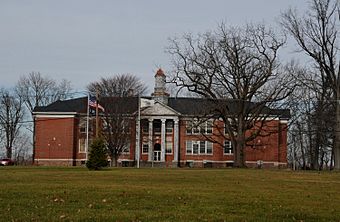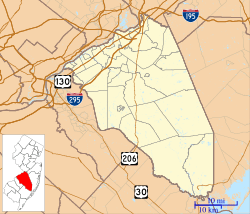Bordentown School facts for kids
Quick facts for kids |
|
|
New Jersey Manual Training and Industrial School for Colored Youth
|
|
 |
|
| Location | N of Burlington Rd., W of I-295, Bordentown, New Jersey |
|---|---|
| Area | 97 acres (39 ha) |
| Built | 1903 |
| Architect | Guilbert and Betelle; Charles N. Lowrie |
| Architectural style | Colonial Revival |
| NRHP reference No. | 97001563 |
| Added to NRHP | January 5, 1998 |
The Bordentown School was a special high school for African-American students. It was located in Bordentown, New Jersey. The school was also known by other names, like the Manual Training and Industrial School for Colored Youth.
For most of its history, it was a public boarding school for both boys and girls. It was often called the "Tuskegee of the North." This was because it used many teaching ideas from the Tuskegee Institute in Alabama. The school closed in 1955.
Contents
How the School Started and What It Taught
The school began in 1886 in New Brunswick. It was started by Reverend Walter A. Rice. He was a minister and a former slave from South Carolina. Rice had fought in the American Civil War. After the war, he moved to New Jersey to get an education.
When it first opened, the school was called "The Ironsides Normal School." Its main goal was to teach African-American students useful skills. These skills would help them support themselves. In 1894, New Jersey passed a law. This law made the school the state's official place for vocational education. Vocational education means learning trades or job skills.
In 1886, the school moved to Bordentown. In 1896, it moved again to a large piece of land there. This land used to belong to a Navy Admiral named Charles Stewart. The state first rented the land, then bought it in 1901.
The school was open all year. It had its own farm, cows, and fruit trees. These supplied food for the school. Students who received scholarships could work on the farm to help pay for their schooling. The school was selective, meaning not everyone could get in. It taught about 500 to 600 students.
At first, the school offered a wide range of subjects, including Classics and Latin. Important thinkers like W. E. B. Du Bois and Booker T. Washington praised its education. Famous people like Albert Einstein and Paul Robeson even gave talks there.
In 1897, James Monroe Gregory became the principal. He had been a Latin Professor at Howard University. He served until 1915. In 1913, Booker T. Washington suggested that the school teach skills that African Americans often used for jobs. For example, he thought boys should learn car repair. He also suggested girls learn "domestic science," which is about running a home.
Students learned a trade along with their regular school subjects. Boys learned farming, car mechanics, and how to operate steam boilers. Girls learned beauty care, dressmaking, and sewing. During the Great Depression, a time of great economic hardship, Bordentown graduates often found jobs more easily. This was because they had learned valuable skills.
The school faced money problems. So, it accepted help from the state. New Jersey eventually took over the school in 1897. In 1945, the New Jersey Department of Education began to oversee it. William R. Valentine was the principal from 1915 until at least 1948. He believed that teaching practical job skills helped students avoid trouble.
Why the School Closed Its Doors
After a new state constitution was passed in 1947, the words "for Colored Youth" were removed from the school's name. It became known as the "State of New Jersey Manual Training School." In 1948, the school opened its doors to students of all races.
In 1955, New Jersey's Governor, Robert B. Meyner, ordered the school to close. He said the school was not able to attract and keep white students. This closing helped end segregation in New Jersey's schools. Segregation means keeping different racial groups separate.
In 1956, there were plans to turn the site into a school for people with developmental disabilities. Many of the original buildings were in poor condition. By 2000, the buildings were being used by the New Jersey Department of Corrections.
The Bordentown School was added to the National Register of Historic Places in 1998. This means it is recognized as an important historical site. A documentary film about the school, called A Place Out of Time — The Bordentown School, was released in 2009. It was shown on PBS in 2010.
Notable Alumni
- Ethel Cuff Black: One of the people who started the Delta Sigma Theta Sorority.
- May Edward Chinn (1896–1980): The first Black woman to graduate from Bellevue Hospital Medical College.
- George Franklin Grant (1846–1910): The inventor of the golf tee.
- George W. Haley (born 1925): A former United States Ambassador to The Gambia. He is the brother of author Alex Haley.
Notable Faculty
- Alan T. Busby (1895–1992): An educator and the first African American graduate of the University of Connecticut.
- Lester Granger (1896–1976): A leader of the National Urban League.
- William H. Hastie (1904–1976): The first African-American Governor of the United States Virgin Islands.




